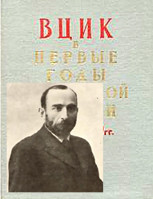
The All-Russian Central Executive Committee of the first convocation elected
17 (30) June 1917 the first All-Russian Congress of Soviets of Workers' and Soldiers' Deputies, which was held from 3 (20) June to 24 June (July 7), 1917, elected the supreme legislative, regulatory and supervisory body of state power in the RSFSR – the All-Russian Central Executive Committee (CEC).
According to factional lists to the Central Executive Committee were elected 250 persons: 104 members and 16 candidates from the Mensheviks; 99 members and 18 candidates from the Socialist Revolutionaries; 35 members and 23 candidates from the Bolsheviks; 8 members and 5 candidates from the United Social-Democratic Party; 3 members and 2 candidates from the Popular Socialists and Trudoviks; 1 member from the Jewish socialist Workers' Party. Above the parties’ lists were elected: Alexander Kerensky, a Socialist-Revolutionary, War and Navy Minister; A. V. Peshekhonov, National Socialist, Minister of Food; M. I. Skobelev, Menshevik, Minister of Labour; I. G. Tsereteli, Menshevik, Minister of Posts and Telegraphs; M. Chernov, Socialist-Revolutionary, Minister of agriculture; N. S. Chkheidze, Menshevik, chairman of the Congress.
At a meeting of the Central Executive Committee 22 June (5 July),1917 was approved its internal structure. The Committee’s apparatus included Presidium, Bureau and about 20 departments. CEC Presidium was the general governing body and was to consist of 9 members who represented the three major factions of the Central Executive Committee: the Mensheviks, the Socialist-Revolutionaries and the Bolsheviks. CEC Bureau was the executive body of the plenum, consisted of 50 persons, including the Presidium; its members were chosen by the principle of proportional representation of all factions, groups of less than 5 persons could unite into a single mission.
At the meeting on 23 June (6 July), 1917 was approved the membership of the CEC Bureau. Under the Central Executive Committee were established the Secretariat, the Executive Committee of peasant section and the following departments: Military, Economic, Agricultural, Food, Railroad, Legislative, Municipal, Literary agitation, Labour, On preparations for the elections to the Constituent Assembly.
Powers of the Central Executive Committee of the 1st convocation, as well as the powers of all commissars and representatives appointed by the former CEC to the Army and locally, ended with the opening of the Second All-Russian Congress of Soviets on October 25 (November 7), 1917 during which the Central Executive Committee of the new composition was elected.
Lit.: Высшие и центральные государственные учреждения России 1801—1917. Т. 1. СПб., 2000. С. 257—260; Декреты Советской власти. Т. 1. М., 1957. № 6. С. 8—9; № 17. С. 23—24; № 88. С. 129—130; № 263. С. 389—390; Центральный государственный архив Октябрьской революции и социалистического строительства: Путеводитель. М., 1946. С. 27.

